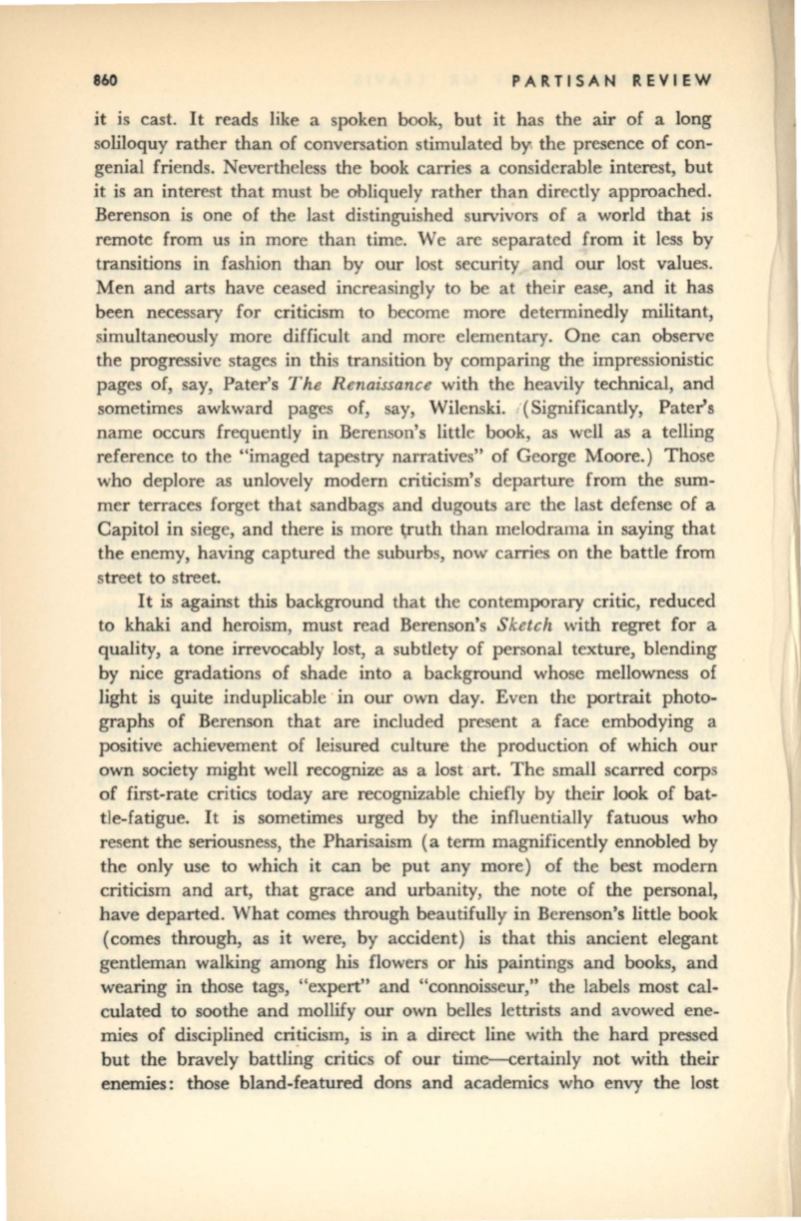
860
PARTISAN REVIEW
it is cast.
It
reads like a spoken book, but it has the air of a long
soliloquy rather than of conversation stimulated bY' the presence of con–
genial friends. Nevertheless the book carries a considerable interest, but
it is an interest that must be obliquely rather than directly approached.
Berenson is one of the last distinguished survivors of a world that is
remote from us in more than time. We are separated from it less by
transitions in fashion than by our lost security and our lost values.
Men and arts have ceased increasingly to be at their ease, and it has
been necessary for criticism to become more determinedly militant,
simultaneously more difficult and more elementary. One can observe
the progressive stages in this transition by comparing the impressionistic
pages of, say, Pater's
The R enaissance
with the heavily technical, and
sometimes awkward pages of, say, Wilenski. i(Significantly, Pater's
name occurs frequently in Berenson's little book, as well as a telling
reference to the "imaged tapestry narratives" of George Moore.) Those
who deplore as unlovely modern criticism's departure from the sum–
mer terraces forget that sandbags and dugouts are the last defense of a
Capitol in siege, and there is more
~ruth
than melodrama in saying that
the enemy, having captured the suburbs, now carries on the battle from
street to street.
It
is against this background that the contemporary critic, reduced
to khaki and heroism, must read Berenson's
Sketch
with regret for a
quality, a tone irrevocably lost, a subtlety of personal texture, blending
by nice gradations of shade into a background whose mellowness of
light is quite induplicable in our own day. Even the portrait photo–
graphs of Berenson that are included present a face embodying a
positive achievement of leisured culture the production of which our
own society might well recognize as a lost art. The small scarred corps
of first-rate critics today are recognizable chiefly by their look of bat–
tle-fatigue.
It
is sometimes urged by the influentially fatuous who
resent the seriousness, the Pharisaism (a term magnificently ennobled by
the only use to which it can be put any more) of the best modern
criticism and art, that grace and urbanity, the note of the personal,
have departed. What comes through beautifully in Berenson's little book
(comes through, as it were, by accident) is that this ancient elegant
gentleman walking among his flowers or his paintings and books, and
wearing in those tags, "expert" and "connoisseur," the labels most cal–
culated to soothe and mollify our own belles lettrists and avowed ene–
mies of disciplined
cri~cism,
is in a direct line with the hard pressed
but the bravely battling critics of our time--certainly not with their
enemies: those bland-featured dons and academics who envy the lost


